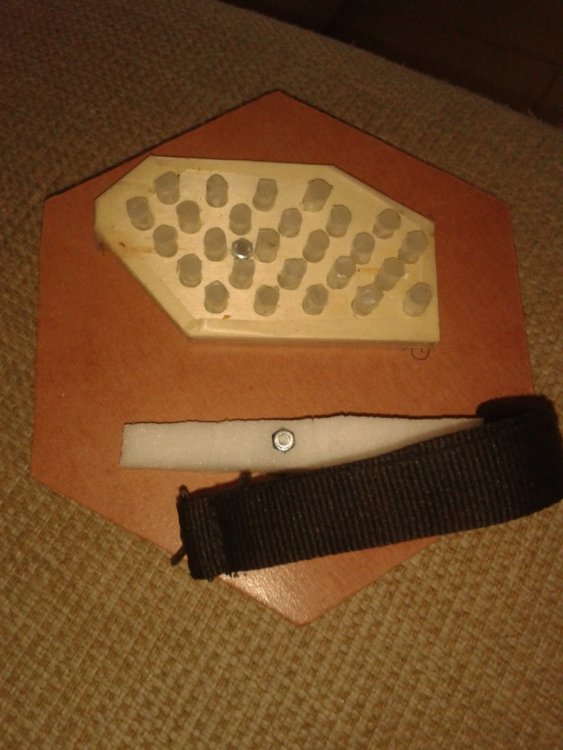-
Posts
130 -
Joined
-
Last visited
Posts posted by Isel
-
-
?
Wow!!!!
-
Thank you Don!.
Effectively, I am inclined to think in the same line as Jim an Don point out.
However , your call to patience is welcome Erik .
Not myself Don, instead I think Alex could do the job a little better...
 .
.
I know jeffries's reed shoes are somewhat smaller than other (even than a short-scaled?? ). But if anyone different from you Erik had told me about 51 buttons in 6 1/4....I didn't consider credible

Could you please, Erik, ellaborate a little more about the role of air button when playing low F?
-
Extremely clear Jim. Thank you very much! !
-
Sorry because my question wasn't stated properly Don.
The question is not to choose between several types of air buttons. Instead is a " to be or not to be" question
 .
.
As far as a I have read, there is an amount of concertinas lacking air button, air lever or whichever air releasing device.
Thinking about a 6 1/4 Hayden duet, where packaging the keys you'd like to include could be more than tricky, I consider perhaps to install an air button wouldn't be a priority.
-
Not a mistake.
Want to be convinced to install an air button in Hayden duet.

Context: when every inch is gold
-
Ops!...problems when uploading files: the upload box shows "Queued"...but nothing happens after that...
I will try to use url-links to Drive:
https://drive.google.com/open?id=1We9FyCd-OwfyvfAhmcudnSLM1TVPvXEX
https://drive.google.com/open?id=1dA_gGWwXwjV5yUosksxS2tw7ORmE2aDt
https://drive.google.com/open?id=18pvrFnpoRQYuN0l7ORPV_qg2K3TV7YN-
-
Just for fun

-
Perhaps you will find usefull this pdf about chordings that Brian Hayden wrote: " All-Systems Duet Workshop Tutor ", which you can find here
I find particularly usefull just the last page!!, as points out to a more general focus in accompaniment than to the specific duet features.
-
As an addition to that John says, I use to develop the following steps:
- follow the singing line (even during someone is singing, but quietly ) by using a partial melody with only the more bass notes I could reach.
-In the bridge you can follow doing this whiles other instruments play the melody.
- in some parts of the melody I can shift between playing the main melody as well or try the melody by thirds.
I thing the sound of the concertina allows to apply the "less is more" principle
 , so even doing very simple arrangement the effect will be nice . This applies especially when several instruments are playing in unisonous, so a litle contribution in terms of harmony is welcome.
, so even doing very simple arrangement the effect will be nice . This applies especially when several instruments are playing in unisonous, so a litle contribution in terms of harmony is welcome.
After you had gained more confidence trying simple arrangements, finally, I thing the most funny is getting carried away by the song, and try to develop some inventive as John said (forgive me... but don't worry so much if some dissonance appear as a result..that is not terrific!

-
Yes Erik, I guess making any swivel in an exagerated way would compromise playing, probably.
But that is not what I have in mind. ?
Neither exagerated swivel nor ultra- complex fingering.
I just look for some "minor" adaptations to take certain advantage in comfort and playability, if possible, as finally a compromise has to be accepted when you choose a particular type slant (or not), pr some specifications of the hand bar, or some spacement of keys, etc.
I took the second picture quickly this morning, after that I realized some uneven things, sorry: the keyboard is so much slided to the left (it should be centered), and the anchor point of the strap in the thumb end should be a litle more to the left, in a place that results in a more natural fitting to the hand (that would coincide more or less with the end bolt location).
-
-
Excusez moi Erik ...I am affraid I don't well understand this example you show

But ...take care! The wild horse is coming!!

The first new rail prototype I made following some of the ideas exposed above resulted very satisfactory to my taste!!.
It Includes:
- the thumb end of the strap would be clamped to the side frame, more or less in the end bolt area (as Erik use in his duet )
- A swiving clamp in the pinkie end of the strap.
- A slope-shape (sorry... I don't know how to name it... ) hand rail. I strongly removed the upper portion in the " L " area of the thumb end, to create a smooth slope that allows the hand to rotate.
This way, I found quite a big improvement on freedom for my hand without -apparently- compromising bellows control. This way I can reach together two stacked buttons from a no- slanted arrangement
-
 ... so several changes in the rail of my prototype are needed, to check these ideas
... so several changes in the rail of my prototype are needed, to check these ideas
-
Thank you Don, Alex, Erik and Lucas!.
I see your points. As far as I understand, the change in the anchor Erik made remembers to me somewhat the Müller arrangement ( isn't Alex? ).
I also contact the handrail with the base of the pinkie, but with my thumb as well.
By experimenting with my keyboard prototype, I notice the " rotation" of the rail I commented above could be imposed by the " L-shape" of the rail in the end where the thumb finger rests, because this "L" blocks the movement of the hand.
I think I wouldn't be comfortable with a thumb strap, instead I consider my way could be to allow some more freedom of the hand by combining Alex's suggestion with a proper adjust of the strap pressure, besides perhaps avoiding the L- shape of the hand rail.
-
3 hours ago, alex_holden said:
one that has a loose central pivot so it can rotate freely
Exactly!.
I am also affraid a completely loose pivot would result in a "wild horse "....The tricky point would be having the option of tightening the " pivot" to preserve certain stability.
-
I have found a somewhat related idea has been considered before. See this post, that includes a more ellaborated proposal, and pictures. here
In other hand, after reading the interesting explanations of mister inventor in the " Wicki-Envi " post , I do think a handrail having the option to free rotate could solve, at least, the problem of consecutively or simultaneously playing stacked buttons (as octaves in hayden duets).
-
Forgive me the crazy answer...... but have you ever seen or thought about a handrail in Hayden duet that could slightly rotate around a " central-located" screw?.
In other words, a handrail attached to the end only by one screw in the middle location, instead by the conventional two screws placed close to both ends of the handrail.
The purpose: to obtain some advantage in reaching the outer buttons with the pinkies if needed; also letting a no-slanted handrail the possibility to adopt a somewhat slant-like configuration for some chording.
-
.... If you can get half of the keys...yo have the half full botle Christine

As Rüdiger said...the skills of playing in an ensemble....
A side comment.... There is a wonderfull TED's talk, by Itay Talgam, describing different styles of conducting an orchestra.... if you can watch it...pay attention on the passage about Von Karajan...

-
 3
3
-
-
I have experienced - still happens- something similar as you tell Christine. Thinking about it, in my case, some causes are:
- I worry to much because other people are hearing me...so I lost concentration in playing.
- I worry to much of having an eventual fail in the tune. ..so I lost concentration in playing.
- I have learned the tune...but including learning some mistakes as well...so these mistakes are prone to appear if I don't feel confident.
It happens to me that I can learn nearly any tune really fast.... but It is needed to learn really well also!!.
A coup of things that are very usefull for me at this respect are:
- As always says the master Itzhak Pearman: "Practice slooowly ".
-...And let the muscles do their job. A silly rule that works for me ( after the piper David Daye) is to play continuosly three times, correctly played, the problematic passages (better if more than three, but it is enough for me )...and stop to let the muscles fix the fingering.
- And the "paradox".... If I dont worry so much of having a mistake.... I gain relax and confidence, so the mistakes do not appear. ...thus I gain more confidence...thus...
Regards
Isra
-
 1
1
-
-
I agree. As has been demonstrated, the quality control of Stagis seems to be weak. In addition, they do not show theirself as very fomal. IMO if a dealer assumes these rols seriously in Europe, all Stagi, the dealer and the future buyers will win....
I have a Stagi Hayden since two years and half. I dont know if the action has any of the improvements that are mentioned, although the mechanics looks like very similar to that shown in pictures exhibited in C.net a few years ago. Yes, the bellows are a bit hard to act, and the keys are hard and make sticky noises, but even so the sound is very sweet, the tuning is perfect and the action response is as quick as the speed your fingers can reach (excepting the very bass keys ). Even respond well to triplets and rolls.
... .so I am happy as this instrument has opened to me the door of the concertina world. However, I hope not being in the door of imploding bellows period as Jody says....

-
 1
1
-
-
Lovely, Steve!!
-
Hipnotic, Adrian!!.

-
Agreeing with a lot of comments made, I think to play fast (and well) you must have a (smiling, of course) devil inside

What about that:
Thank you for lot of enjoyable recordings Simon!!
-
Hello!. Only to remember a lot of interesting opinions about the hayden slant were covered in the thread "Starting Out On Hayden Duet, Advice?".here
Some questions are, however, still on the air, as example: after Rich Morse's convincing arguments in favour to slant, finnally the Beaumont Hayden has parallel...
In other hand... Ron, the obscure temptation of choising a mirrored left layout (wicky style)...is strong for me...(Master Joda...where are you right now!!!)?





WTB C air button
in General Concertina Discussion
Posted
astonishing!